Earthquake Scenarios for Seismic Performance Assessment of Essential Facilities: Case Study of Fire Stations in Montreal
Abstract
1. Introduction
2. Materials and Methods
2.1. Framework for Performance Assessment
2.2. Seismic Hazard Model
2.3. Inventory Model
2.4. Fragility Model
2.5. Impact Model
3. Results and Discussion
3.1. Scenario-Based-Spreadsheet Integrated Tool
3.2. Simulations for Several Epicentres
3.2.1. Damage Scenarios for Epicenters Using Square Grid Points
3.2.2. Damage Scenario for Epicenters Using Triangular Grid Points
4. Discussion
5. Conclusions
Author Contributions
Funding
Data Availability Statement
Conflicts of Interest
References
- Sezgin, S.K.; Sakcalı, G.B.; Özen, S.; Yıldırım, E.; Avcı, E.; Bayhan, B.; Çağlar, N. Reconnaissance report on damage caused by the February 6, 2023, Kahramanmaraş Earthquakes in reinforced-concrete structures. J. Build. Eng. 2024, 89, 109200. [Google Scholar] [CrossRef]
- Goda, K.; Mori, N.; Miyashita, T.; De Risi, R.; Chang, Z. Near-fault ground motions and regional shaking damage assessment of the 2024 Noto Peninsula Earthquake in Japan. Bull. Earthq. Eng. 2025, 23, 1829–1858. [Google Scholar] [CrossRef]
- Mousavi, S.; Bagchi, A.; Kodur, V.K. Review of post-earthquake fire hazard to building structures. Can. J. Civ. Eng. 2008, 35, 689–698. [Google Scholar] [CrossRef]
- Scawthorn, C.; Eidinger, J.M.; Schiff, A. (Eds.) Fire Following Earthquake; ASCE: Reston, VA, USA, 2005. [Google Scholar]
- Schencking, J.C. The Great Kanto Earthquake and the culture of catastrophe and reconstruction in 1920s Japan. J. Jpn. Stud. 2008, 34, 295–331. [Google Scholar] [CrossRef]
- Himoto, K. Comparative analysis of post-earthquake fires in Japan from 1995 to 2017. Fire Technol. 2019, 55, 935–961. [Google Scholar] [CrossRef]
- Scawthorn, C. Fire Following Earthquake in the Montreal Region; Institute for Catastrophic Loss Reduction: Toronto, ON, Canada, 2019. [Google Scholar]
- Scawthorn, C. Fire Following Earthquake in the Vancouver Region; Institute for Catastrophic Loss Reduction: Toronto, ON, Canada, 2020. [Google Scholar]
- Hwang, H.H.M.; Lin, H.; Huo, J.-R. Seismic performance evaluation of fire stations in Shelby County, Tennessee. Earthq. Spectra 1997, 13, 759–772. [Google Scholar] [CrossRef]
- Miniati, R.; Iasio, C. Methodology for rapid seismic risk assessment of health structures: Case study of the hospital system in Florence, Italy. Int. J. Disaster Risk Reduct. 2012, 2, 16–24. [Google Scholar] [CrossRef]
- Favier, P.; Poulos, A.; Vásquez, J.A.; Aguirre, P.; de la Llera, J.C. Seismic risk assessment of an emergency department of a Chilean hospital using a patient-oriented performance model. Earthq. Spectra 2019, 35, 489–512. [Google Scholar] [CrossRef]
- Natural Resources Canada. Earthquake Zones in Eastern Canada. Available online: https://www.seismescanada.rncan.gc.ca/zones/eastcan-en.php#WQSZ (accessed on 1 December 2024).
- Ma, S.; Eaton, D.W. Western Quebec seismic zone (Canada): Clustered, midcrustal seismicity along a Mesozoic hot spot track. J. Geophys. Res. 2007, 112. [Google Scholar] [CrossRef]
- National Research Council of Canada (NRCC). National Building Code of Canada (NBCC) 2020; National Research Council of Canada (NRCC): Ottawa, ON, Canada, 2020; Volume 1, Division B, Part 4; pp. 4-1–4-127.
- Atkinson, G.M.; Adams, J. Ground motion prediction equations for application to the 2015 Canadian national seismic hazard maps. Can. J. Civ. Eng. 2013, 40, 988–998. [Google Scholar] [CrossRef]
- Service de Sécurité Incendie de Montréal. Rapport des Activités 2022. Available online: https://sim.montreal.ca/rapport-des-activites (accessed on 1 December 2024).
- Statistique Canada. Profil du Recensement, Recensement de la Population de 2021. Produit nº 98-316-X2021001 au Catalogue de Statistique Canada. Available online: https://www12.statcan.gc.ca/census-recensement/2021/dp-pd/prof/index.cfm?Lang=F (accessed on 1 December 2024).
- Roca, A.; Goula, X.; Oliveira, C.S. (Eds.) Assessing and Managing Earthquake Risk: Geo-Scientific and Engineering Knowledge for Earthquake Risk Mitigation: Developments, Tools, Techniques; Springer: Berlin/Heidelberg, Germany, 2006. [Google Scholar]
- Krinitzsky, E.L. Deterministic versus probabilistic seismic hazard analysis for critical structures. Eng. Geol. 1995, 40, 1–7. [Google Scholar] [CrossRef]
- Puri, N.; Jain, A. Deterministic seismic hazard analysis for the state of Haryana, India. Indian Geotech. J. 2015, 46, 164–174. [Google Scholar] [CrossRef]
- Mase, L.Z. Seismic hazard vulnerability of Bengkulu City, Indonesia, based on deterministic seismic hazard analysis. Geotech. Geol. Eng. 2020, 38, 5433–5455. [Google Scholar] [CrossRef]
- Gerstenberger, M.C.; Marzocchi, W.; Allen, T.; Pagani, M.; Adams, J.; Danciu, L.; Field, E.H.; Fujiwara, H.; Luco, N.; Ma, K.; et al. Probabilistic seismic hazard analysis at regional and national scales: State of the art and future challenges. Rev. Geophys. 2020, 58, e2019RG000653. [Google Scholar] [CrossRef]
- Peñarubia, H.C.; Johnson, K.L.; Styron, R.H.; Bacolcol, T.C.; Sevilla, W.I.G.; Perez, J.S.; Bonita, J.D.; Narag, I.C.; Solidum, R.U., Jr.; Pagani, M.M.; et al. Probabilistic seismic hazard analysis model for the Philippines. Earthq. Spectra. 2020, 36, 44–68. [Google Scholar] [CrossRef]
- Robinson, T.R.; Rosser, N.J.; Densmore, A.L.; Oven, K.J.; Shrestha, S.N.; Guragain, R. Use of scenario ensembles for deriving seismic risk. Proc. Natl. Acad. Sci. USA 2018, 115, E9532–E9541. [Google Scholar] [CrossRef]
- Nollet, M.-J.; El Ezz, A.A.; Surprenant, O.; Smirnoff, A.; Nastev, M. Earthquake magnitude and shaking intensity dependent fragility functions for rapid risk assessment of buildings. Geosciences 2018, 8, 16. [Google Scholar] [CrossRef]
- El Ezz, A.A.; Smirnoff, A.; Nastev, M.; Nollet, M.-J.; McGrath, H. ER2-Earthquake: Interactive web-application for urban seismic risk assessment. Int. J. Disaster Risk Reduct. 2019, 34, 326–336. [Google Scholar] [CrossRef]
- Halchuk, S.; Allen, T.I.; Adams, J.; Rogers, G.C. Fifth Generation Seismic Hazard Model Input Files as Proposed to Produce Values for the 2015 National Building Code of Canada; Geol. Surv; Canada, Open-File Report. 7576; Natural Resources Canada: Ottawa, ON, Canada, 2014. [Google Scholar]
- Humar, J. Background to some of the seismic design provisions of the 2015 National Building Code of Canada. Can. J. Civ. Eng. 2015, 42, 940–952. [Google Scholar] [CrossRef]
- Rosset, P.; Bour-Belvaux, M.; Chouinard, L. Microzonation models for Montreal with respect to VS 30. Bull. Earthq. Eng. 2015, 13, 2225–2239. [Google Scholar] [CrossRef]
- Federal Emergency Management Agency. Multi-Hazard Loss Estimation Methodology: Earthquake Model HAZUS-MH 2.1: Technical Manual; Federal Emergency Management Agency: Washington, DC, USA, 2011.
- Ruggieri, S.; Calò, M.; Cardellicchio, A.; Uva, G. Analytical-mechanical based framework for seismic overall fragility analysis of existing RC buildings in town compartments. Bull. Earthq. Eng. 2022, 20, 8179–8216. [Google Scholar] [CrossRef]
- Lessault, T. Évaluation de la Vulnérabilité Sismique des Casernes de Pompiers de Montréal. Master’s Thesis, École de Technologie Supérieure, Montréal, QC, Canada, 2023. [Google Scholar]
- Données Québec. Caserne des Pompiers. 2023. Available online: https://www.donneesquebec.ca/recherche/dataset/vmtl-casernes-pompiers/resource/5b9c0e1d-3f75-4e98-b53d-6e979c18cc98 (accessed on 1 December 2023).
- Service de Sécurité Incendie de Montréal. Building Maps-Fire Stations. Available online: https://sim.montreal.ca/en/map-fire-stations (accessed on 1 December 2023).
- Mitchell, D.; Paultre, P.; Tinawi, R.; Saatcioglu, M.; Tremblay, R.; Elwood, K.; Adams, J.; DeVall, R. Evolution of seismic design provisions in the National building code of Canada. Can. J. Civ. Eng. 2010, 37, 1157–1170. [Google Scholar] [CrossRef]
- Bai, J.-W.; Hueste, M.B.D.; Gardoni, P. Probabilistic assessment of structural damage due to earthquakes for buildings in Mid-America. J. Struct. Eng. 2009, 135, 1155–1163. [Google Scholar] [CrossRef]
- Kolaj, M.; Halchuk, S.C.; Adams, J.E. Sixth-Generation Seismic Hazard Model of Canada: Grid Values of Mean Hazard to be Used with the 2020 National Building Code of Canada; (Open File 8950); Natural Resources Canada: Ottawa, ON, Canada, 2023. [Google Scholar]
- Goulet, C.A.; Bozorgnia, Y.; Kuehn, N.; Al Atik, L.; Youngs, R.R.; Graves, R.W.; Atkinson, G.M. PEER 2017/03-NGA-East Ground-Motion Models for The U.S. Geological Survey National Seismic Hazard Maps; PEER Report No. 2017/03; Pacific Earthquake Engineering Research Center: Berkeley, CA, USA, 2017; pp. 1–180. [Google Scholar]
- Kolaj, M.; Allen, T.; Mayfield, R.; Adams, J.; Halchuk, S. Ground-motion models for the 6th Generation Seismic Hazard Model of Canada. In Proceedings of the 12th Canadian Conference on Earthquake Engineering, Quebec, QC, Canada, 17–20 June 2019; pp. 17–20. [Google Scholar]
- Federal Emergency Management Agency. Techniques for the Seismic Rehabilitation of Existing Buildings; FEMA 547; Federal Emergency Management Agency: Washington, DC, USA, 2006.
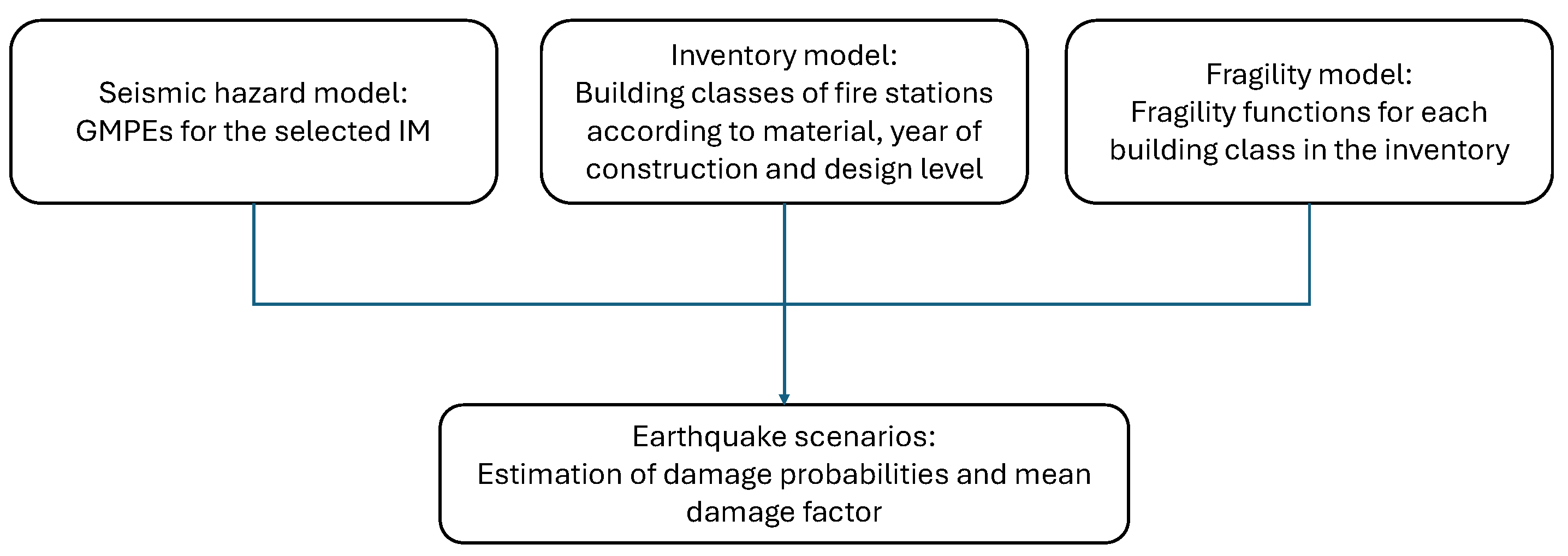
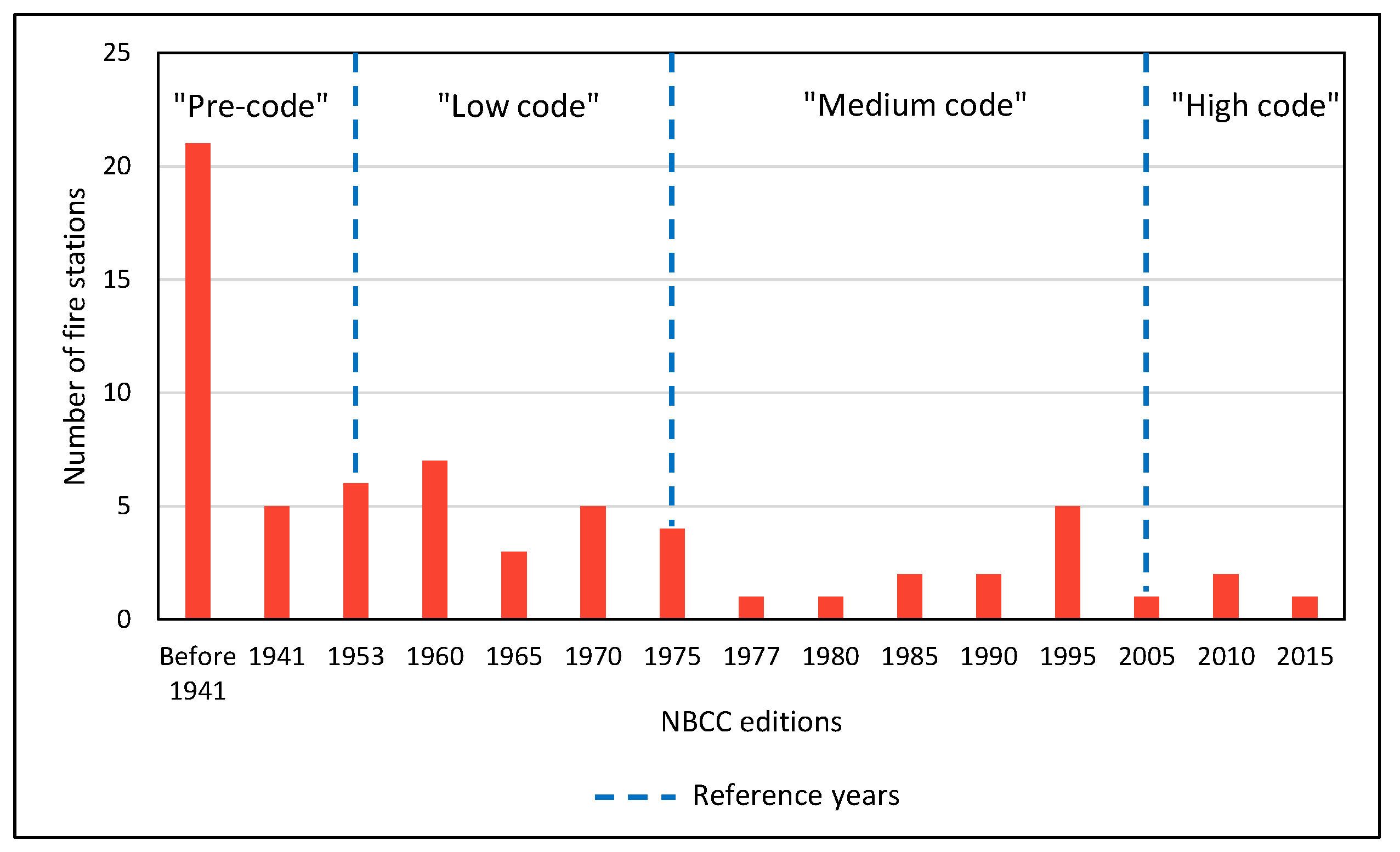
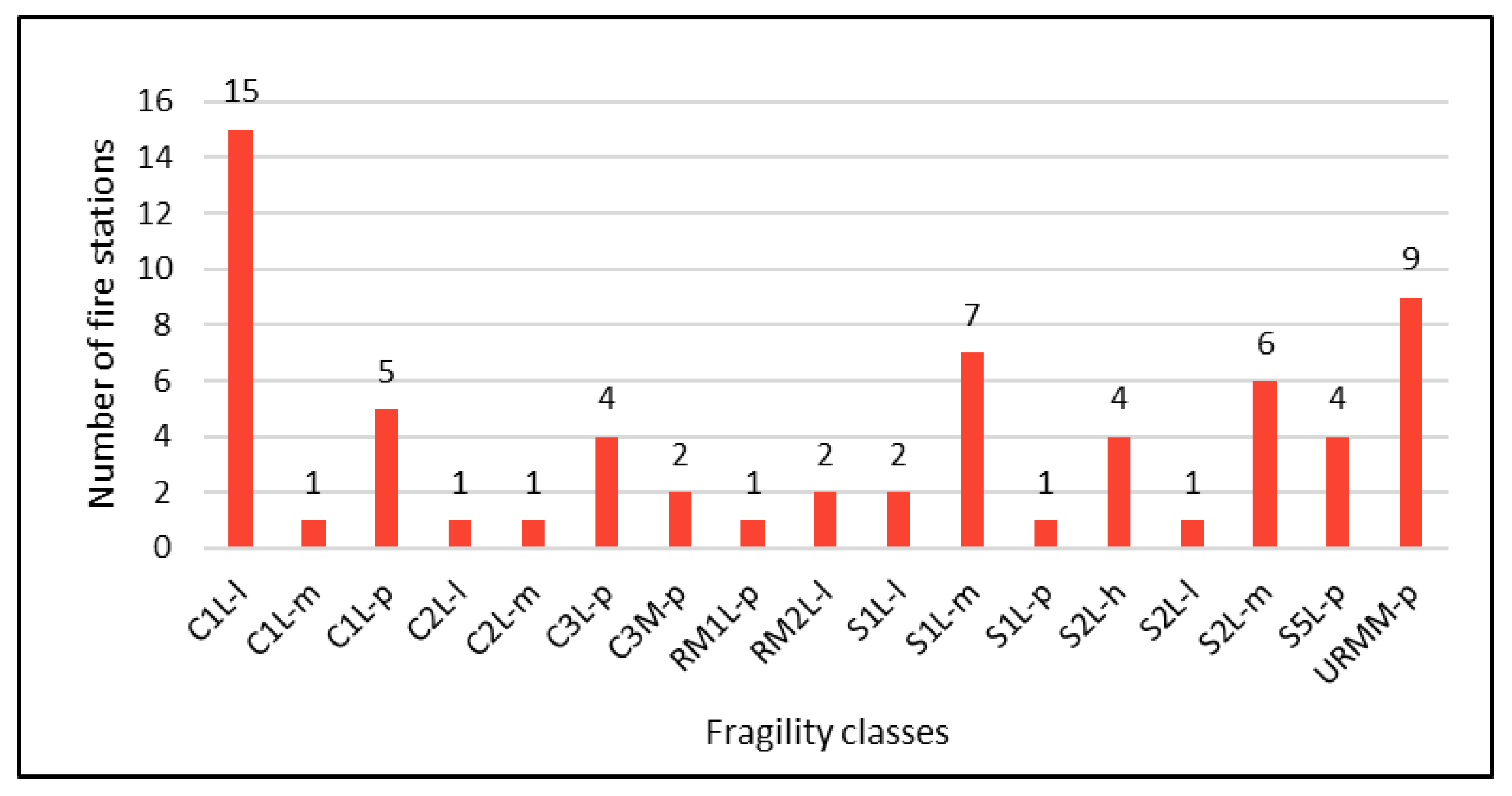
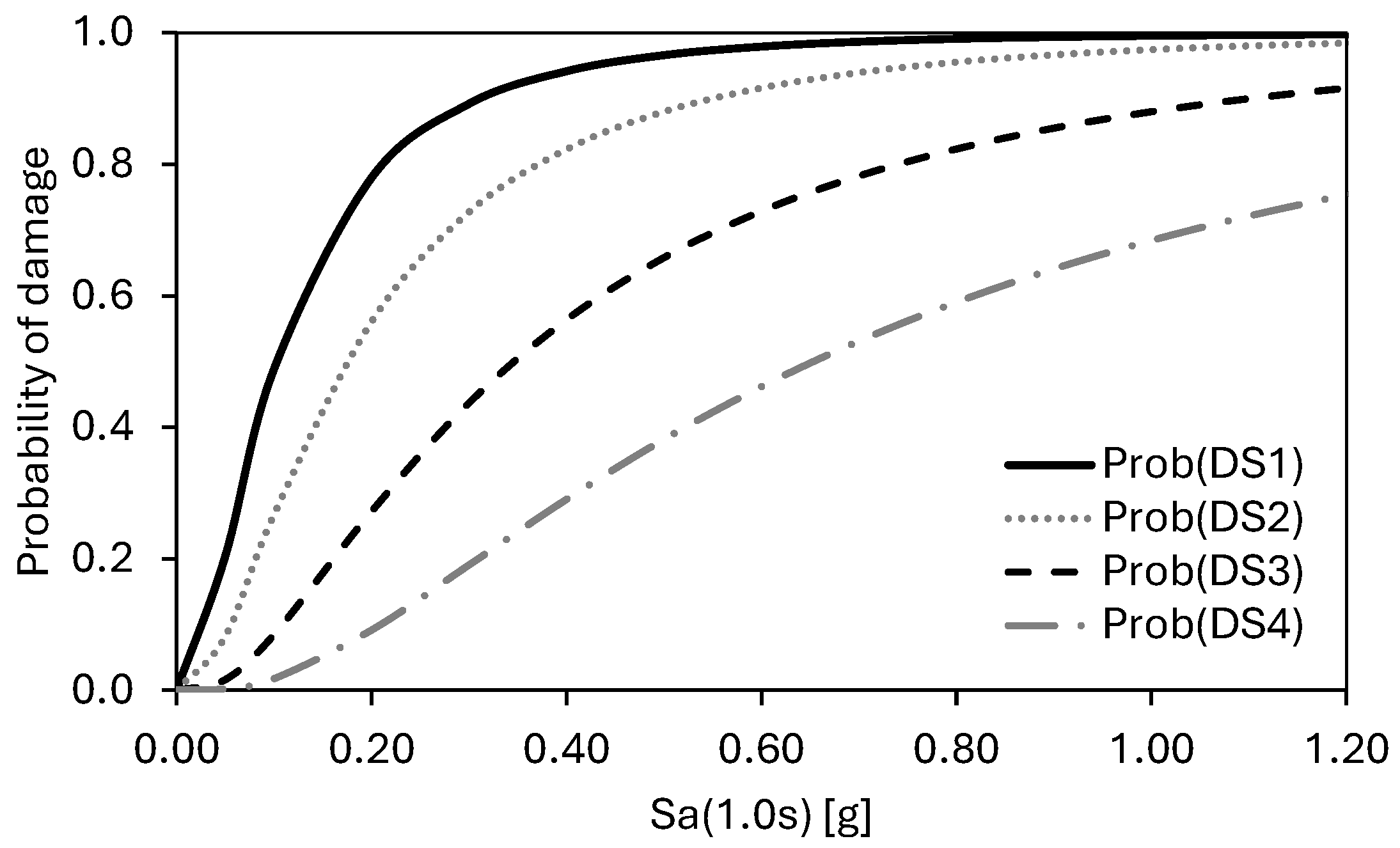


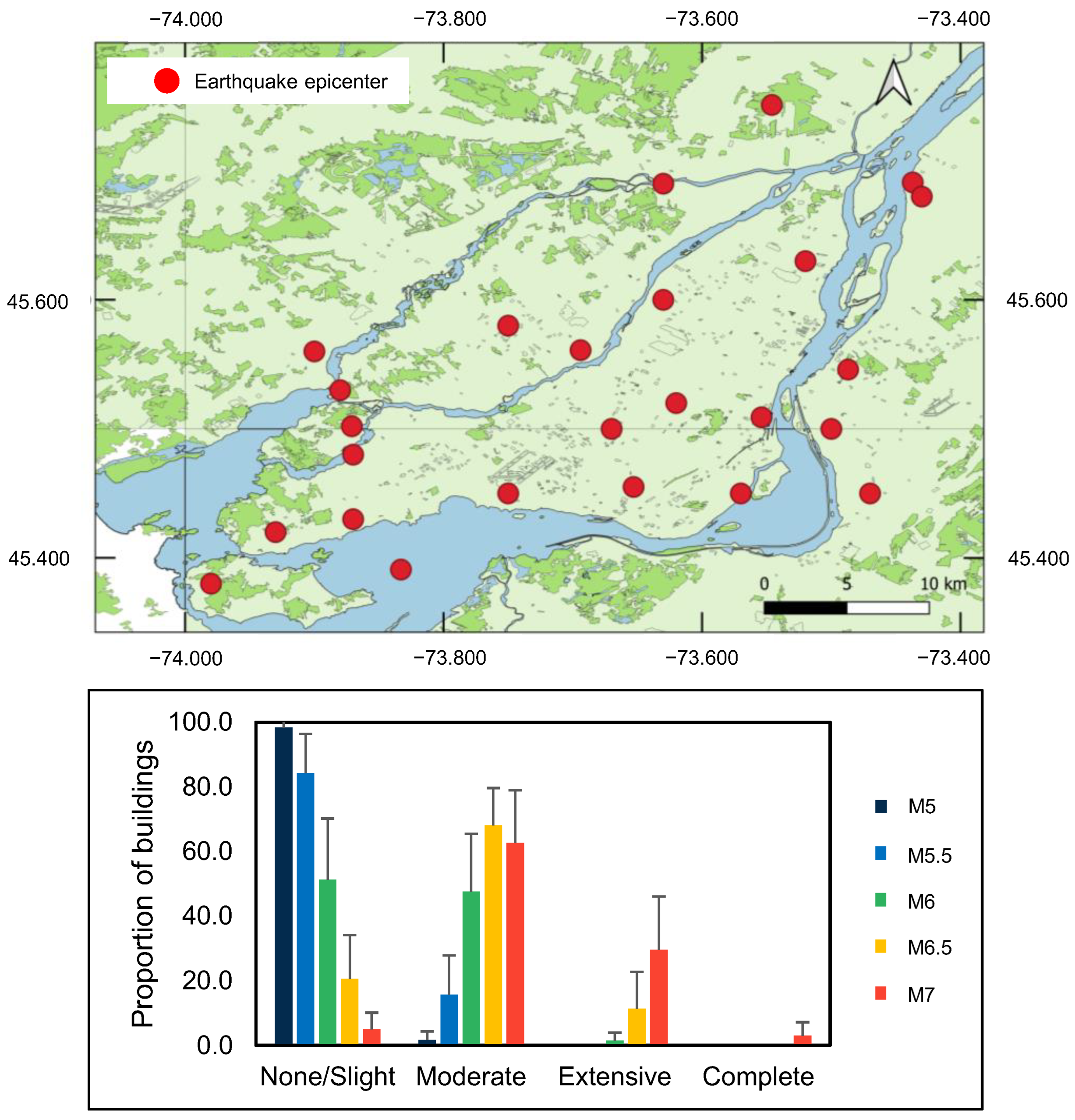
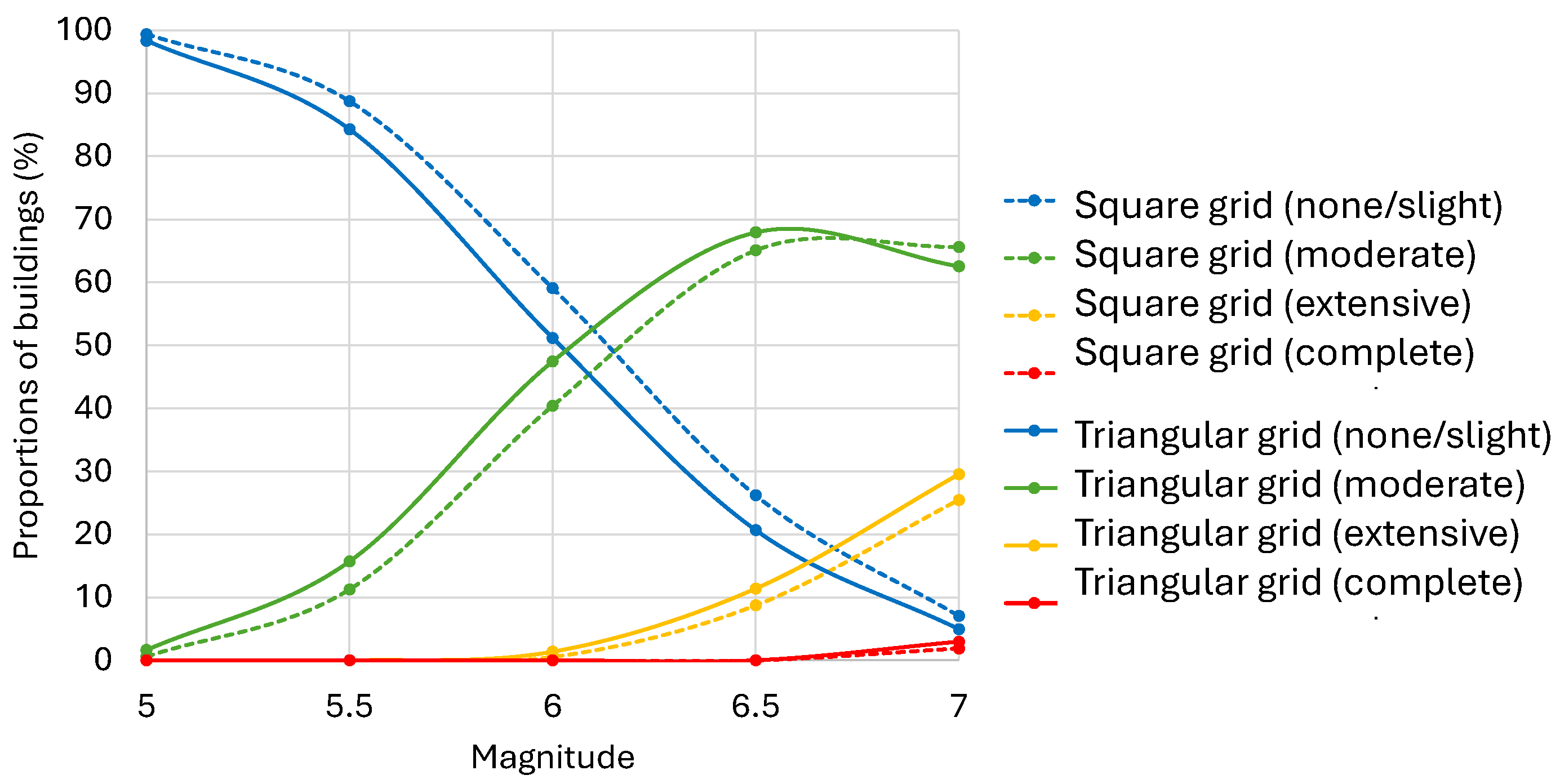
| GMPE Level | Magnitude | (cm/s2) |
|---|---|---|
| Low | M5 | |
| M5.5 | ||
| M6 | ||
| M6.5 | ||
| M7 | ||
| Medium | M5 | |
| M5.5 | ||
| M6 | ||
| M6.5 | ||
| M7 | ||
| High | M5 | |
| M5.5 | ||
| M6 | ||
| M6.5 | ||
| M7 |
| Site Class | Vs30 Range (m/s) | Number of Fire Stations Located at Each Class |
|---|---|---|
| A: hard rock | Vs30 > 1500 m/s | 1 |
| B: rock | 760 < Vs30 < 1500 m/s | 22 |
| C: very dense soil and soft rock | 360 < Vs30 < 760 m/s | 35 |
| D: stiff soil | 180 < Vs30 < 360 m/s | 8 |
| Material | Lateral Load Resisting System | Label | Height Subclasses | Code Levels |
|---|---|---|---|---|
| Steel buildings | Steel moment frame | S1 | S1L (low-rise) | _p (pre-code) _l (low-code) _m (mid-code) _h (high-code) |
| S1M (mid-rise) | ||||
| Steel braced frame | S2 | S2L (low-rise) | ||
| S2M (mid-rise) | ||||
| Steel light frame | S3 | S3L (low-rise) | ||
| S3M (mid-rise) | ||||
| Steel frame with cast in place concrete shear walls | S4 | S3L (low-rise) | ||
| S4M (mid-rise) | ||||
| Steel frame with unreinforced masonry infill walls | S5 | S5L (low-rise) | ||
| S5M (mid-rise) | ||||
| Concrete buildings | Concrete moment frame | C1 | C1L (low-rise) | _p (pre-code) _l (low-code) _m (mid-code) _h (high-code) |
| C1M (mid-rise) | ||||
| Concrete shear walls | C2 | C2L (low-rise) | ||
| C2M (mid-rise) | ||||
| Concrete frame with unreinforced masonry infill walls | C3 | C3L (low-rise) | ||
| C3M (mid-rise) | ||||
| Reinforced masonry buildings | Reinforced masonry bearing walls with wood or metal deck diaphragms | RM1 | RM1L (low-rise) | _p (pre-code) _l (low-code) _m (mid-code) _h (high-code) |
| RM1M (mid-rise) | ||||
| Reinforced masonry bearing walls with precast concrete diaphragms | RM2 | RM2L (low-rise) | ||
| RM2M (mid-rise) | ||||
| Unreinforced masonry buildings | Unreinforced masonry bearing walls | URM | URML (low-rise) | _p (pre-code) _l (low-code) |
| URMM (mid-rise) |
| Damage State | Range (%) | |
|---|---|---|
| ) | 0–1 | |
| ) | 1–30 | |
| ) | 30–80 | |
| ) | 80–100 |
| Damage State | |||||
|---|---|---|---|---|---|
| None/Slight | Moderate | Extensive | Complete | ||
| GMPE | Low | ||||
| Medium | |||||
| High | |||||
| Map | Damage State | Equation |
|---|---|---|
| Square grid | None/Slight | |
| Moderate | ||
| Extensive | ||
| Complete | ||
| Triangular grid | None/Slight | |
| Moderate | ||
| Extensive | ||
| Complete |
Disclaimer/Publisher’s Note: The statements, opinions and data contained in all publications are solely those of the individual author(s) and contributor(s) and not of MDPI and/or the editor(s). MDPI and/or the editor(s) disclaim responsibility for any injury to people or property resulting from any ideas, methods, instructions or products referred to in the content. |
© 2025 by the authors. Licensee MDPI, Basel, Switzerland. This article is an open access article distributed under the terms and conditions of the Creative Commons Attribution (CC BY) license (https://creativecommons.org/licenses/by/4.0/).
Share and Cite
Lessault, T.; Abo El Ezz, A.; Nollet, M.-J. Earthquake Scenarios for Seismic Performance Assessment of Essential Facilities: Case Study of Fire Stations in Montreal. GeoHazards 2025, 6, 22. https://doi.org/10.3390/geohazards6020022
Lessault T, Abo El Ezz A, Nollet M-J. Earthquake Scenarios for Seismic Performance Assessment of Essential Facilities: Case Study of Fire Stations in Montreal. GeoHazards. 2025; 6(2):22. https://doi.org/10.3390/geohazards6020022
Chicago/Turabian StyleLessault, Thomas, Ahmad Abo El Ezz, and Marie-José Nollet. 2025. "Earthquake Scenarios for Seismic Performance Assessment of Essential Facilities: Case Study of Fire Stations in Montreal" GeoHazards 6, no. 2: 22. https://doi.org/10.3390/geohazards6020022
APA StyleLessault, T., Abo El Ezz, A., & Nollet, M.-J. (2025). Earthquake Scenarios for Seismic Performance Assessment of Essential Facilities: Case Study of Fire Stations in Montreal. GeoHazards, 6(2), 22. https://doi.org/10.3390/geohazards6020022






